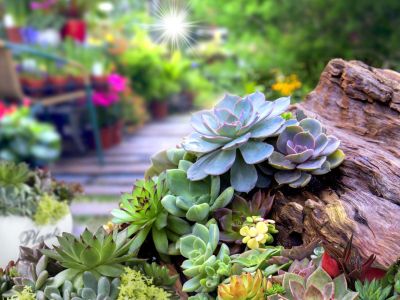Succulent Garden Design
Succulents are generally drought-tolerant plants that have thick leaves where they store moisture. Although succulent plants are very tolerant of dry conditions, they do need water, especially during the growing season. Succulent garden design should consider the location, soil type, configuration, moisture level, and the types of plants. Some succulents are more drought tolerant than others. Do a little research on the wide variety of succulent shapes and sizes before starting a succulent garden outside. For instance, cacti are succulents and hold water in their stems and pads. Other types of succulents are not spiny but have swollen leaves with a myriad of growth habits. There are spreading or drooping types, such as burro’s tail; spiky, wide plants like agave; or tall, columned varieties such as old man’s cactus. Plan the design with enough space for the plants to fill in as they grow.
Succulent Outdoor Plants
Growing a succulent garden outside starts with plant choices. If you are a novice, begin with plants that are easy and foolproof. Sedum and sempervivum are easy to grow and adaptable to bright, sunny locations or even slightly dappled areas. Whatever types of plants you choose, succulents need well-drained soil. They can thrive in cracks and crevasses, rockeries, and sandy or gritty soils. Succulents in cool-season areas will do best in containers that are brought indoors for the winter. Try some kalanchoe, aloe, echeveria, and aeonium. Have fun with the unique sizes, shapes, and textures of these plants. Use succulent outdoor plants as part of a xeriscape area of the garden, to conserve water and provide interest and color.
How to Plan an Outdoor Succulent Garden
When you’ve chosen your plants and are ready for planting, you will need to know how to plan an outdoor succulent garden. Choose a sunny location and plot the space you want to fill. Check the soil conditions and drainage by digging a hole at least 1 foot (0.5 m.) deep and filling it with water. If the water drains within a half-hour, the soil is sufficiently porous. If not, simply mix in 3 inches (7.5 cm.) of sand or another gritty material to increase the texture and drainage. Use taller specimens at the center of the area and spreading species at the edges or dotted among the larger plants as ground cover. Top the area with a layer of pebbles or small rocks to act as mulch. This will help prevent weeds and conserve moisture while allowing evaporation of excess water.
Care of Succulent Garden Plants
Succulent plants tolerate periods of dryness but should receive regular water during the growing season. When soil is dry a couple of inches (5 cm.) down, water deeply and then let the soil dry out again between waterings. The most common problem with succulents is rot. Keeping the stems out of the soil and providing drying periods between irrigation will help prevent this. Also, water from the base of the plant to keep leaves dry. Watch for insect pests and combat them with sprays of water and horticultural soap spray. Remove dead stems and offsets during the care of succulent garden plants. An offset is easy to start as a completely new plant. Put offsets in a well-drained potting mix and care for them until the roots are full and healthy, then plant them in a new area of the garden.
